IJCRR - 13(12), June, 2021
Pages: 49-53
Date of Publication: 22-Jun-2021
Print Article
Download XML Download PDF
A Pilot Study on Variation of Blood Pressure of Undergraduate Students in Summer and Winter Seasons
Author: Anurag Singh Gautam, Girish Singh, Ashutosh Kumar Pathak
Category: Healthcare
Abstract:Introduction: The seasonal variation of blood pressure has been demonstrated in various researches but the studies on the variation of blood pressure in students of the northern region of India is very sparse, also the data regarding the prevalence of prehypertension in Undergraduate students of the Varanasi region is lacking. Aims: This study aims to find the mean blood pressure variation of undergraduate students in the summer and winter season and to screen male and female students in the prehypertensive stage. Method: It was a longitudinal pilot study in which blood pressure of undergraduate students of Faculty of Ayurveda, Institute of Medical Sciences, Banaras Hindu University was measured in two different seasons i.e. summer and winter. A total of 50 students 25 (50%) males and 25 (50%) females of age 18 to 25 years were included in the study. Result and Conclusion: Mean of systolic blood pressure as well as diastolic blood pressure were significantly higher in the winter season as compared to the summer season. The mean difference between systolic blood pressure and diastolic blood pressure in the winter and summer season was 6.26 mmHg and 6.54mmHg, respectively. The mean of systolic blood pressure of males was significantly higher as compared to females in both winter and summer season by the difference of 11 mmHg in winter and 10 mmHg in summer which was statistically significant (P< 0.005)whereas the difference in diastolic blood pressure was found out to be non-significant. Out of 50 subjects, 19 (38%) subjects in the summer season and 25 (50%) subjects in the winter season were in the prehypertensive stage.
Keywords: Blood pressure, Prehypertension, Season, Summer, Winter
Full Text:
INTRODUCTION
In today’s era, due to lifestyle changes, there is an increase in metabolic diseases like hypertension, diabetes mellitus etc. These diseases are occurring individually as well combined in a manner of the syndrome. Hypertension is one of these and its cases are increasing day by day. Its pattern and associated factors are still being studied ( Table 1).
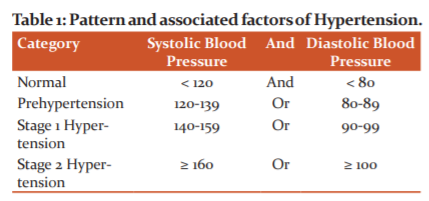
The Seventh Report of the Joint National Committee on the Prevention Detection, Evaluation, and Treatment of High Blood Pressure (JNC VII) introduced a hypertension category “pre-hypertension”, defined as a systolic blood pressure of 120 to 139 mmHg or diastolic blood pressure of 80 to 89 mmHg.1
Various conditions affect blood pressure levels in a normal and diseased person. The effect of seasonal variations on blood pressure is a well-established fact. This effect is more pronounced in humid subtropical regions like Varanasi where the temperature (49°F to 106°F), as well as humidity (2% to 100%) variation, is quite high.
Many studies are depicting the variation of blood pressure in different seasons. Studies from the eastern part of the Delhi area shows that there is high blood pressure during the winter season as compared to the summer season and a study from Punjab stated that cardiovascular morbidity and mortality increases during the winter season. In these two studies of the north Indian region. It was found that the mean difference between winter and summer was 9.01 mmHg and 11mmHgfor systolic blood pressure and 5.61mmHg and 6.79 mmHg for diastolic blood pressure respectively.2,3 Two studies in which one is from the Guwahati region in Assam and the other is Iranian study of Tehran on adult population shows that mean the difference among summer and winter systolic blood pressure was 2 mmHg and 3 mmHg and diastolic blood pressure was1 mmHg and 2 mmHg respectively.4,5
There are studies on student population also as in a study it was found that756 (22.3%) out of 3385 students of Shimla district in Himachal Pradesh were in prehypertensive stage.6 and in other study of Government medical college, Andhara Pradesh 103 (37.45%) students out of 275 were in prehypertensive stage.7 Out of 84 medical students in karnataka 42 (50%) were prehypertensive.8 140 (25.9%) students were in prehypertensive stage out of 540 students of South Ghana in rainy season.9 and in other studies, it was found that 57 (37.1%) out of 155 students of Northeast Malaysia were prehypertensive in south-west monsoon season.10 and81 (12.83%) out of 631 students of Erode district of Tamil Nadu were in the prehypertensive stage.11
Lacunae -
This pilot study is part of a study on the effect of marma therapy on blood pressure in different seasons on prehypertensive undergraduate students. Due to the lack of data on the variation of blood pressure of undergraduate students of the northern region in a different season as well as the prevalence of prehypertension among undergraduate students of the northern region, need arises to study the effect of different seasons on blood pressure variations among undergraduate students of the northern region. Thus, it was decided to do a pilot study and evaluate findings for further large samples.
AIM AND OBJECTIVE
This study aims -
-
to find the mean blood pressure variation in male and female students in the summer and winter season.
-
to compare blood pressure variation among students in the summer and winter season.
-
to explore the number of male and female students in the prehypertensive stage.
MATERIAL AND METHOD
50 students of the BAMS course of Faculty of Ayurveda, IMS, BHU who had given consent to participate in the study were recruited for the study, 25 males and 25 females of age between 18 to 25 years were included. Blood pressure was measured in two different seasons, summer and winter in month of February and May. Blood pressure was measured thrice in left arm and the mean blood pressure was taken. Blood pressure was measured by AccuSureTSBlood pressure Monitor Model No: TMB-1112-A. Approved Mark: IND/09/13/141.This blood pressure data taken in Varanasi area where temperature range between 9 º C to 42º C. In month of February the mean temperature was 19.35º C and in month of May mean temperature was34.2º C. When data is taken in May temperature was 37º C and humidity was 27% and in month of February temperature was 22º C and humidity 18%.
Statistical Methods:
The data were analyzed by statistical software SPSS version 20. Paired t-test was applied to test whether variation in mean systolic blood pressure, as well as diastolic blood pressure in both summer and winter season, is statistically significant or not. Variables that had p< 0.05 were considered statistically significant.
Ethical Clearance Number:
The pilot study is part of the study “A study on the effect of talahridaya marma therapy on blood pressure of prehypertensive students in different seasons” approved by the ethical committee of Institute of Medical Sciences, Banaras Hindu University with reference no- Dean/2019/EC/1336
Inclusion criteria
1. Undergraduate students of Ayurveda (BAMS) course, Faculty of Ayurveda, Institute of Medical Sciences, Banaras Hindu University, Varanasi, India
2. Males and females of the age group of 18 to 25 years.
Exclusion criteria
-
Students were not willing to participate in the study.
<
RESULT
The result was as follows -
Table 2 shows that the mean of systolic blood pressure in the winter season was 125.72±13.393mmHg as compared to summer season 119.46±12.296 mmHg which is statistically significant. Diastolic blood pressure in the winter season (78.02±9.228 mmHg) is also observed higher than in summer (71.48±7.363). Paired t-test for both systolic as well as diastolic blood pressure in the summer and winter season was found statistically significant.

Table 3 shows that the mean systolic blood pressure of female student in the winter season (120.44±13.225 mmHg) as compared to summer (114.56±9.372 mmHg) where the difference is statistically significant. Mean diastolic blood pressure in winter and summer is 77.52±9.156 mmHg and 70.00±8.036 mmHg respectively which is higher by 7.32±7.403mmHg. Paired t-test is statistically significant for the diastolic blood pressure of female between the summer and winter season.
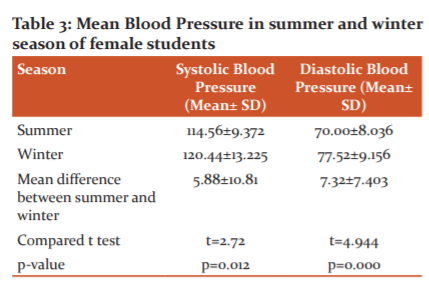
Table 4 shows that the mean of systolic blood pressure of male student was 131.00±11.54 mmHg in winter season as compared to summer 124.36±13.06 which is statistically significant whereas for diastolic blood pressure in winter and summer season it was 78.52±9.460 mmHg and 72.76±6.533 respectively which is statistically significant.
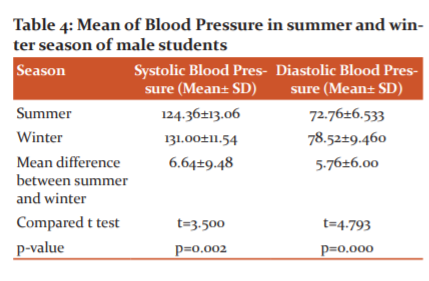
Table 5 shows the result of an unpaired t-test between the blood pressures of male and female in both seasons. Mean systolic blood pressure differ statistically significantly between male and female for summer as well as winter whereas, the diastolic blood pressure difference between summer and winter season was found to be not statistically significant.
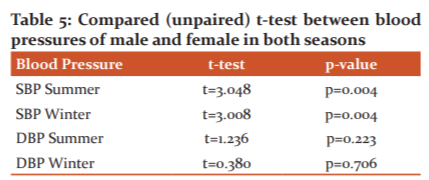
Table 6 shows that 11(44%) males and 8(32%)females in the summer season and 14(56%) males and11(44%)females in the winter season were having blood pressure in the prehypertensive stage.
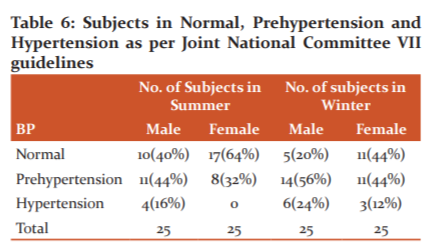
Table 7 shows that there were 19(38%) subjects in the summer season and 25(50%) subjects in the winter season who were in a pre-hypertensive stage.
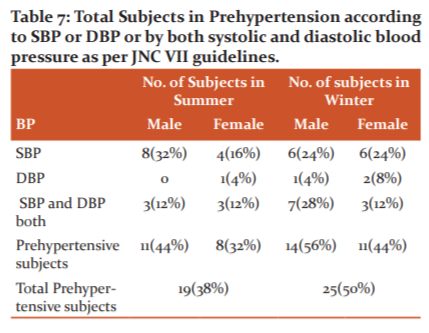
DISCUSSION:
In the study, it was found that the mean systolic blood pressure of all students in the winter season was 125.72mmHg as compared to the summer season 119.46 mmHg which is significantly higher by 6.26 mmHg. Diastolic blood pressure of winter season was 78.02 mmHg which was significantly higher than summer 71.48 by 6.54 mmHg. There are various reasons for the increase in blood pressure in winter seasons such as vasoconstriction, endothelial dysfunction and reduced sweating. It shows that temperature and humidity are negatively correlated with blood pressure. A study from north India reported that the mean difference between winter and summer was 9.01 mmHg systolic blood pressure and 5.61mmHg diastolic blood pressure which slightly differs from this study. Another study from the eastern part of the Delhi area shows means difference between winter and summer was 11 mmHg for systolic blood pressures and 7 mmHg for diastolic blood pressures.
Mean of systolic blood pressure of male students were significantly higher as compared to female students in both summer and winter season. This may be due to the hormone estrogen protects female from high blood pressure thus males have high blood pressure in comparison to females [12]. The mean of systolic as well as diastolic blood pressure of male students in the winter season was significantly higher as compared to the summer season.
In this study, 38%students were in the prehypertensive stage in the summer season and 50%were prehypertensive in the winter season in which 44% males and 32% females in the summer season and 56% males and 44% females in the winter season were in the prehypertensive stage. It signifies a marked rise in systolic and diastolic blood pressure in the winter season in comparison to the summer season. These findings differ from several previous studies where it was found that 25.9% of students in one study, 37% and 43% of students in other studies were in the prehypertensive stage.
LIMITATION:
It has been observed that the observed systolic blood pressure lies in the range mentioned in the review of the literature but the diastolic blood pressure in this study is observed to slightly differ from the range. This may be due to the small sample size of (50 students) in this study.
SUGGESTIONS :
The finding of this study suggests that there is considerable variation in the blood pressure in the subtropical region like Varanasi. Therefore, the guideline should be framed to measure the blood pressure of students in the winter season every year.
The finding of the study also suggests that the screening of the students for prehypertension should be done from the undergraduate level, so that early detection will lead to the identification of intervention through lifestyle modification & counselling hence will check the burden of disease in society.
CONCLUSION :
The mean of systolic blood pressure and diastolic blood pressure of the undergraduate students were significantly higher in the winter season as compared to summer by a mean difference of 6.26 mmHg in systolic blood pressure and 6.54 mmHg in diastolic blood pressures. The mean of systolic blood pressure of males was significantly higher as compared to females in both winter and summer season by the difference of 11 mmHg in winter and 10 mmHg in summer which is statistically significant (P<0.005) whereas the difference in diastolic blood pressure was found out to be non-significant. Out of 50 subjects, 19(38%) subjects in the summer season and 25(50%) subjects in the winter season were in the prehypertensive stage according to JNC guidelines. The observation thus obtained here is the outcome of the pilot study, therefore in future, there is a need to evaluate the findings in a large sample size.
ACKNOWLEDGEMENT:
We thank Dr. Piyush Verma (PhD scholar) for his help and support in data collection, analysis and reporting.
CONFLICT OF INTEREST AND SOURCE OF FUNDING:
Nil
AUTHOR CONTRIBUTION
Anurag Singh Gautam, the corresponding author has done the literature review with collection and analysis of the data. He has also reported the findings.
Dr. Girish Singh has helped in the statistical analysis of the data and preparation of result.
Dr. Ashutosh Kumar Pathak has designed and supervised the study.
References:
1. Investigation O. The Prevalence of Prehypertension and Hypertension Among US Adults According to the New Joint National Committee Guidelines. 2004;164; 2126-2134
2. Sinha P, Tanoja D, Singh N, Saha R. Seasonal variation in the prevalence of hypertension: Implications for interpretation. Indian J Public Health. 2010;54(1):7.
3. Chakrabarty M, Bora B. The measurement of blood pressure in the winter season and its correlation with blood pressure after cold exposure in summer season: a cross-sectional study in Gauhati medical college and hospital, Guwahati, Assam, India. Int J Res Med Sci. 2017;5(7):3111-3113.
4. Askari S, Asghari G, Ghanbarian A, Khazan M, Alamdari S, Azizi F. Seasonal variations of blood pressure in adults: Tehran lipid and glucose study. Arch Iran Med. 2014;17(6):441–443.
5. Goyal A, Aslam N, Kaur S, Soni RK, Midha V, Chaudhary A, et al. Factors affecting seasonal changes in blood pressure in North India: A population-based four-seasons study. Ind Heart J.2018; 70 (8): 360-367.
6. Prehypertension and Hypertension and its Determinants among Adolescent School Children of a Semi-urban /Area in Erode District, Tamil Nadu. Ind Heart J. 2017;4(12):155–60.
7. Chitrapu RV, Thakkallapalli ZM. Prehypertension among Medical Students and its Association with Cardiovascular Risk Factors. Ind Heart J. 2015;4(1):8–12.
8. Krishndasa SN. Pre-Hypertension in Apparently Healthy Young Adults?: Incidence and Influence of Haemoglobin Level. Int J Res Med Sci. 2015;9(11);10–12.
9. Rafan SNH, Zakaria R, Ismail SB, Muhamad R. Prevalence of prehypertension and its associated factors among adults visiting the outpatient clinic in Northeast Malaysia. J Taibah University Med Sci. 2018;13(5):459–64.
10. Anuradha G, Muraleetharan G, Abinaya R, Tamilkodi M, Sachithanantham S. Prevalence
pressure. Br Med J. 1982;285(6346):919–23.
11. Ojeda NB, Grigore D, Robertson EB, Alexander BT. Estrogen Protects Against Increased Blood Pressure in Postpubertal Female Growth Restricted Offspring. Br Med J. 2007;50;679–85.
12. Brennan PJ, Greenberg G, Miall WE, Thompson SG. Seasonal variation in arterial blood Mahajan A, Negi P. Hypertension and pre-hypertension among adolescents in Shimla, Northern India-Time to awaken. Niger J Cardiol. 2015;12(2):71-76.
13. Keatinge WR, Coleshaw SR, Cotter F, Mattock M, Murphy M, Chelliah R. Increases in platelet and red cell counts, blood viscosity, and arterial pressure during mild surface cooling: factors in mortality from coronary and cerebral thrombosis in winter. Bri Med J. 2009;289(6456):1405–1408.
14. Singh Gautam A, Pathak AK. Greentree Group Publishers Effect of Seasonal Variation on Blood Pressure-A Review. Int J Ayu Pharm Chem. 2019;11(2);664-669.
15. Gyamfi D, Obirikorang C, Acheampong E, Danquah KO, Asamoah EA, Liman FZ, et al. Prevalence of pre-hypertension and hypertension and its related risk factors among undergraduate students in a Tertiary institution, Ghana. Alexandria J Med. 2018;54(4):475–80.
16. Chandrashekhar R, Basagoudar S. Study of Hypertension and Its Risk Factors Among Women of Reproductive Age Group. Int J Ayu Pharm Chem. 2013;05(22):27–32.
|






 This work is licensed under a Creative Commons Attribution-NonCommercial 4.0 International License
This work is licensed under a Creative Commons Attribution-NonCommercial 4.0 International License